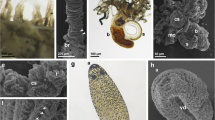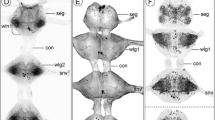Abstract
In certain gastropod mollusks, the central neurons VD1 and RPD2 express a distinct peptide, the so-called VD1/RPD2 α1-neuropeptide. In order to test whether this peptide is also present in the complex cephalopod central nervous system (CNS), we investigated several octopod and squid species. In the adult decapod squid Idiosepius notoides the α1-neuropeptide is expressed throughout the CNS, with the exception of the vertical lobe and the superior and inferior frontal lobes, by very few immunoreactive elements. Immunoreactive cell somata are particularly abundant in brain lobes and associated organs unique to cephalopods such as the subvertical, optic, peduncle, and olfactory lobes. The posterior basal lobes house another large group of immunoreactive cell somata. In the decapod Idiosepius notoides, the α1-neuropeptide is first expressed in the olfactory organ, while in the octopod Octopus vulgaris it is first detected in the olfactory lobe. In prehatchlings of the sepiolid Euprymna scolopes as well as the squids Sepioteuthis australis and Loligo vulgaris, the α1-neuropeptide is expressed in the periesophageal and posterior subesophageal mass. Prehatchlings of L. vulgaris express the α1-neuropeptide in wide parts of the CNS, including the vertical lobe. α1-neuropeptide expression in the developing CNS does not appear to be evolutionarily conserved across various cephalopod taxa investigated. Strong expression in different brain lobes of the adult squid I. notoides and prehatching L. vulgaris suggests a putative role as a neurotransmitter or neuromodulator in these species; however, electrophysiological evidence is still missing.






Similar content being viewed by others
References
Bogerd J, Geraerts WPM, Van Heerikhuizen H, Kerkhoven RM, Joosse J (1991) Characterization and evolutionary aspects of a transcript encoding a neuropeptide precursor of Lymnaea neurons, VD1 and RPD2. Mol Brain Res 11:47–54
Bogerd J, Van Kesteren RE, Van Heerikhuizen H, Geraerts WPM, Veenstra J, Smit AB, Joosse J (1993) Alternative splicing generates diversity of VD1/RPD2 α peptides in the central nervous system of lymnaea stagnalis. Cell Mol Neurobiol 13:123–136
Bogerd J, Li KW, Jiménez CR, van der Schors RC, Ebberink RHM, Geraerts WPM (1994) Processing, axonal transport and cardioregulatory functions of peptides derived from two related prohormones generated by alternative splicing of a single gene in identified neurons VD1 and RPD2 of Lymnaea. Mol Brain Res 23:66–72
Boyer C, Maubert E, Charnay Y, Chichery R (2007) Distribution of neurokinin A-like and serotonin immunoreactivities within the vertical lobe complex in Sepia officinalis. Brain Res 1133:53–66
Buck LB, Bigelow JM, Axel R (1987) Alternative splicing in individual Aplysia neurons generates neuropeptide diversity. Cell 51:127–133
Bullock TH, Horridge GA (1965) Structure and function in the nervous systems of invertebrates. Freeman, San Francisco
Di Cosmo A, Di Cristo C (2006) Molluscan bioactive peptides. In: Kastin AJ (ed) Handbook of biologically active peptides. Academic, Amsterdam, pp 235–240
Ellis I, Kempf SC (2011) Characterization of the central nervous system and various peripheral innervations during larval development of the oyster Crassostrea virginica. Invert Biol 130:251–263
Kastin AJ (2006) Handbook of biologically active peptides. Academic, Amsterdam
Kerkhoven RM, Croll RP, Van Minnen J, Bogerd J, Ramkema MD, Lodder H, Boer HH (1991) Axonal mapping of the giant peptidergic neurons VD1 and RPD2 located in the CNS of the pond snail Lymnaea stagnalis, with particular reference to the innervation of the auricle of the heart. Brain Res 565:6–16
Kerkhoven RM, Croll RP, Ramkema MD, Van Minnen J, Bogerd J, Boer HH (1992) The VD1/RPD2 neuronal system in the central nervous system of the pond snail Lymnaea stagnalis studied by in situ hybridization and immunocytochemistry. Cell Tiss Res 267:551–559
Kerkhoven RM, Ramkema MD, Van Minnen J, Croll RP, Pin T, Boer HH (1993) Neurons in a variety of molluscs react to antibodies raised against the VD1/RPD2 α-neuropeptide of the pond snail Lymnaea stagnalis. Cell Tiss Res 273:371–379
Kocot KM, Cannon JT, Todt C, Citarella MR, Kohn AB, Meyer A, Santos SR, Schander C, Moroz LL, Lieb B, Halanych KM (2011) Phylogenomics reveals deep molluscan relationships. Nature 477:452–456
Marquis F (1989) Die Embryonalentwicklung des Nervensystems von Octopus vulgaris lam. (Cephalopoda, Octopoda), eine histologische Analyse. Verh Naturforsch Ges Basel 99:23–76
Meister G (1972) Organogenese von Loligo vulgaris LAM. (Mollusca, Cephalopoda, Teuthoidea, Myopsida, Loliginidae). Inaugural dissertation, Universität Basel
Messenger JB (1979) The nervous system of Loligo: IV. The peduncle and olfactory lobes. Phil Trans R Soc Lond B 285:275–309
Naef A (1928) Cephalopoda embryology. Fauna and flora of the Bay of Naples. Part I, Vol. II. Translated from German. Smithsonian Institution Libraries, Washington, DC
Ponder WF, Lindberg DR (2008) Phylogeny and evolution of the Mollusca. University of California Press, Berkeley
Rodriguez J, Deinhard F (1960) Preparation of a semipermanent mounting medium for fluorescent antibody studies. Virology 12:316–317
Shigeno S, Tsuchiya K, Segawa S (2001) Embryonic and paralarval development of the central nervous system of the loliginid squid Sepioteuthis lessoniana. J Comp Neurol 437:449–475
Shigeno S, Yamamoto M (2002) Organization of the nervous system in the pygmy cuttlefish, Idiosepius paradoxus Ortmann (Idiosepiidae, Cephalopoda). J Morphol 254:65–80
Wildenburg G (1997) Structure of the so-called olfactory organ of octopods after hatching: Evidence for its chemoreceptive function. Vie Milieu 47:137–142
Wollesen T, Loesel R, Wanninger A (2009) Pygmy squids and giant brains: mapping the complex cephalopod CNS by phalloidin staining of vibratome sections and whole-mount preparations. J Neurosci Meth 178:63–67
Wollesen T, Cummins SF, Degnan BM, Wanninger A (2010a) FMRFamide gene and peptide expression during central nervous system development of the cephalopod mollusk, Idiosepius notoides. Evol Dev 12:113–130
Wollesen T, Degnan BM, Wanninger A (2010b) Expression of serotonin (5-HT) during CNS development of the cephalopod mollusk, Idiosepius notoides. Cell Tiss Res 342:161–178
Wollesen T, Sukhsangchan C, Seixas P, Nabhitabhata J, Wanninger A (2012) Analysis of neurotransmitter distribution in brain development of benthic and pelagic. J Morphol, in press
Yamamoto M (1988) Normal embryonic stages of the pygmy cuttlefish, Idiosepius pygmaeus paradoxus Ortmann. Zool Sci 5:989–998
Yamamoto M, Shimazaki Y, Shigeno S (2003) Atlas of the embryonic brain in the pygmy squid, Idiosepius paradoxus. Zool Sci 20:163–179
Young JZ (1971) The anatomy of the nervous system of Octopus vulgaris. Clarendon, Oxford
Young JZ (1977) The nervous system of Loligo: III. Higher motor centres: The basal supraesophageal lobes. Phil Trans R Soc Lond B 276:351–398
Young JZ (1979) The nervous system of Loligo: V. The vertical lobe complex. Phil Trans R Soc Lond B 285:311–354
Author information
Authors and Affiliations
Corresponding author
Rights and permissions
About this article
Cite this article
Wollesen, T., Nishiguchi, M.K., Seixas, P. et al. The VD1/RPD2 α1-neuropeptide is highly expressed in the brain of cephalopod mollusks. Cell Tissue Res 348, 439–452 (2012). https://doi.org/10.1007/s00441-012-1378-8
Received:
Accepted:
Published:
Issue Date:
DOI: https://doi.org/10.1007/s00441-012-1378-8




